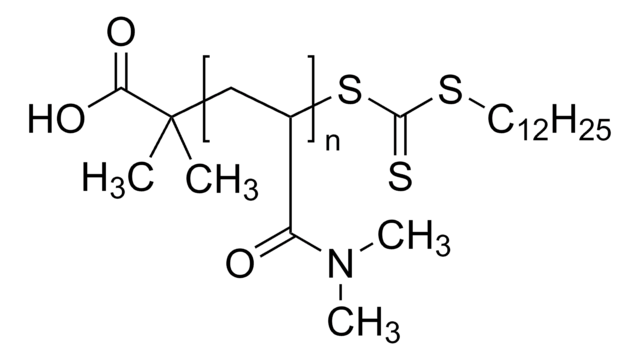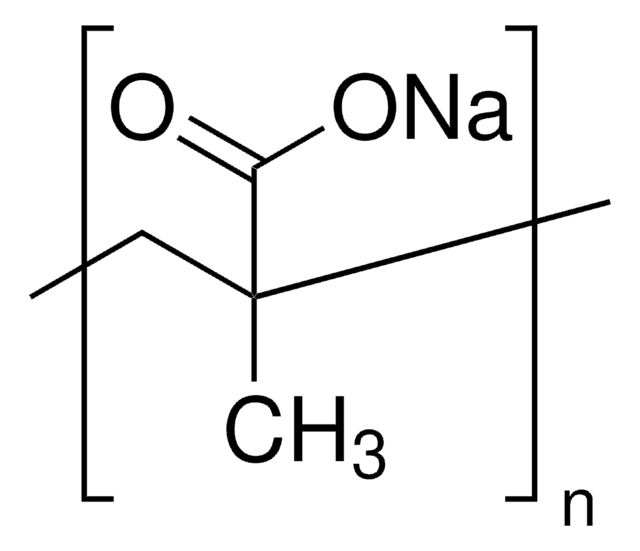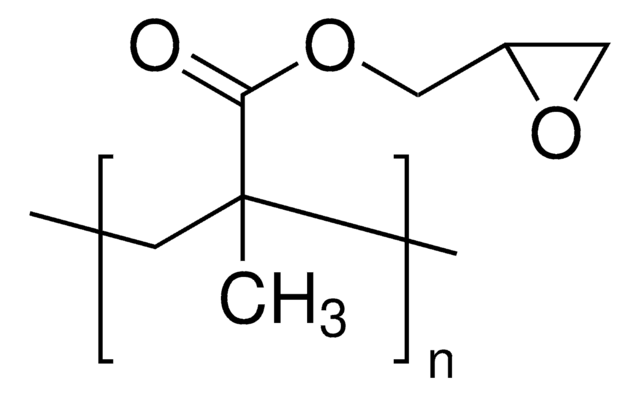529265
Poly(2-hydroxyethylmethacrylat)
average Mv 20,000
Synonym(e):
Poly-(2-HEMA), Poly-HEMA
About This Item
Empfohlene Produkte
Form
powder
Qualitätsniveau
Mol-Gew.
average Mv 20,000
Übergangstemp.
Tg 84.8 °C
Dichte
1.15 g/mL at 25 °C (lit.)
SMILES String
CC(=C)C(=O)OCCO
InChI
1S/C6H10O3/c1-5(2)6(8)9-4-3-7/h7H,1,3-4H2,2H3
InChIKey
WOBHKFSMXKNTIM-UHFFFAOYSA-N
Suchen Sie nach ähnlichen Produkten? Aufrufen Leitfaden zum Produktvergleich
Anwendung
- Hydrogen-bonds structure in poly(2-hydroxyethyl methacrylate) studied by temperature-dependent infrared spectroscopy: Investigates the hydrogen-bond structure in poly(2-hydroxyethyl methacrylate) (PHEMA) using temperature-dependent IR spectroscopy. (S Morita, 2014).
- Transparent and tough poly(2-hydroxyethyl methacrylate) hydrogels prepared in water/IL mixtures: Describes the development of tough and transparent PHEMA hydrogels for potential use in various biomedical applications. (Y Liu et al., 2020).
- Reduced cell attachment to poly(2-hydroxyethyl methacrylate)-coated ventricular catheters in vitro: Examines how PHEMA coatings can reduce cell attachment, which is beneficial for biomedical devices like catheters. (BW Hanak et al., 2018).
- Surface modification of poly(2-hydroxyethyl methacrylate) hydrogel for contact lens application: Studies modifications to PHEMA hydrogels to improve their suitability for contact lens applications. (M Kazemi Ashtiani, M Zandi, 2018).
Physikalische Form
Lagerklassenschlüssel
11 - Combustible Solids
WGK
WGK 3
Flammpunkt (°F)
Not applicable
Flammpunkt (°C)
Not applicable
Persönliche Schutzausrüstung
Eyeshields, Gloves, type N95 (US)
Hier finden Sie alle aktuellen Versionen:
Besitzen Sie dieses Produkt bereits?
In der Dokumentenbibliothek finden Sie die Dokumentation zu den Produkten, die Sie kürzlich erworben haben.
Kunden haben sich ebenfalls angesehen
Artikel
Professor Shrike Zhang (Harvard Medical School, USA) discusses advances in 3D-bioprinted tissue models for in vitro drug testing, reviews bioink selections, and provides application examples of 3D bioprinting in tissue model biofabrication.
Professor Shrike Zhang (Harvard Medical School, USA) discusses advances in 3D-bioprinted tissue models for in vitro drug testing, reviews bioink selections, and provides application examples of 3D bioprinting in tissue model biofabrication.
Self-assembled monolayers (SAMs) have attracted enormous interest for a wide variety of applications in micro- and nano-technology. In this article, we compare the benefits of three different classes of SAM systems (alkylthiolates on gold.
Biomaterials science involves the design and fabrication of smart materials for studying, directing, or mimicking biology. For successful integration of biomaterials in biological research, a meaningful understanding of biological systems is required.
Unser Team von Wissenschaftlern verfügt über Erfahrung in allen Forschungsbereichen einschließlich Life Science, Materialwissenschaften, chemischer Synthese, Chromatographie, Analytik und vielen mehr..
Setzen Sie sich mit dem technischen Dienst in Verbindung.










